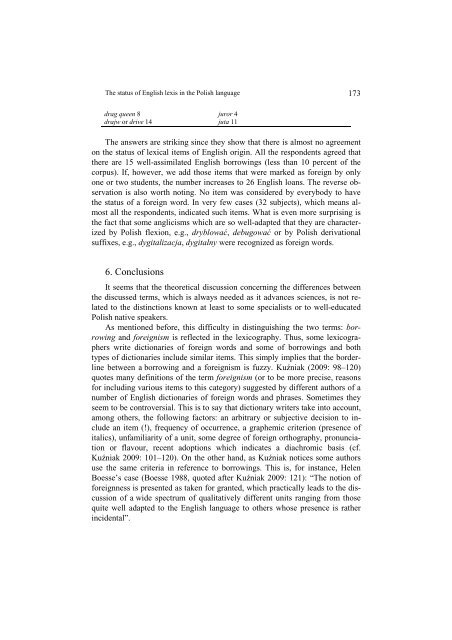s - Wyższa SzkoÅa Filologiczna we WrocÅawiu
s - Wyższa SzkoÅa Filologiczna we WrocÅawiu
s - Wyższa SzkoÅa Filologiczna we WrocÅawiu
You also want an ePaper? Increase the reach of your titles
YUMPU automatically turns print PDFs into web optimized ePapers that Google loves.
The status of English lexis in the Polish language 173<br />
drag queen 8 juror 4<br />
drajw or drive 14 juta 11<br />
The ans<strong>we</strong>rs are striking since they show that there is almost no agreement<br />
on the status of lexical items of English origin. All the respondents agreed that<br />
there are 15 <strong>we</strong>ll-assimilated English borrowings (less than 10 percent of the<br />
corpus). If, ho<strong>we</strong>ver, <strong>we</strong> add those items that <strong>we</strong>re marked as foreign by only<br />
one or two students, the number increases to 26 English loans. The reverse observation<br />
is also worth noting. No item was considered by everybody to have<br />
the status of a foreign word. In very few cases (32 subjects), which means almost<br />
all the respondents, indicated such items. What is even more surprising is<br />
the fact that some anglicisms which are so <strong>we</strong>ll-adapted that they are characterized<br />
by Polish flexion, e.g., dryblować, debugować or by Polish derivational<br />
suffixes, e.g., dygitalizacja, dygitalny <strong>we</strong>re recognized as foreign words.<br />
6. Conclusions<br />
It seems that the theoretical discussion concerning the differences bet<strong>we</strong>en<br />
the discussed terms, which is always needed as it advances sciences, is not related<br />
to the distinctions known at least to some specialists or to <strong>we</strong>ll-educated<br />
Polish native speakers.<br />
As mentioned before, this difficulty in distinguishing the two terms: borrowing<br />
and foreignism is reflected in the lexicography. Thus, some lexicographers<br />
write dictionaries of foreign words and some of borrowings and both<br />
types of dictionaries include similar items. This simply implies that the borderline<br />
bet<strong>we</strong>en a borrowing and a foreignism is fuzzy. Kuźniak (2009: 98–120)<br />
quotes many definitions of the term foreignism (or to be more precise, reasons<br />
for including various items to this category) suggested by different authors of a<br />
number of English dictionaries of foreign words and phrases. Sometimes they<br />
seem to be controversial. This is to say that dictionary writers take into account,<br />
among others, the following factors: an arbitrary or subjective decision to include<br />
an item (!), frequency of occurrence, a graphemic criterion (presence of<br />
italics), unfamiliarity of a unit, some degree of foreign orthography, pronunciation<br />
or flavour, recent adoptions which indicates a diachromic basis (cf.<br />
Kuźniak 2009: 101–120). On the other hand, as Kuźniak notices some authors<br />
use the same criteria in reference to borrowings. This is, for instance, Helen<br />
Boesse’s case (Boesse 1988, quoted after Kuźniak 2009: 121): “The notion of<br />
foreignness is presented as taken for granted, which practically leads to the discussion<br />
of a wide spectrum of qualitatively different units ranging from those<br />
quite <strong>we</strong>ll adapted to the English language to others whose presence is rather<br />
incidental”.
















